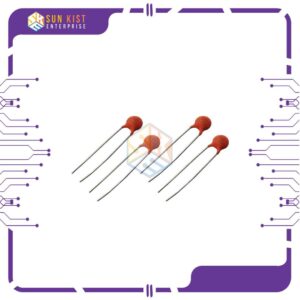Description
A 100µF (microfarad) 25V capacitor is an electronic component designed to store and release electrical energy in a circuit. Here’s a description of a 100µF 25V capacitor:
Capacitance Value:
The capacitance value is 100 microfarads (µF), which represents the capacitor’s ability to store a certain amount of electrical charge. In practical terms, it signifies the capacitor’s capacity to store energy when a voltage is applied across its terminals.
Voltage Rating:
The voltage rating is 25 volts (V), indicating the maximum voltage the capacitor can withstand without risking damage. It’s crucial to choose a capacitor with a voltage rating higher than the maximum voltage it will experience in the circuit to prevent breakdown or failure.
Type:
The description doesn’t specify the capacitor type, but it is common for capacitors of this value and voltage to be electrolytic capacitors. Electrolytic capacitors are polarized, meaning they have a positive and a negative terminal. Observing the correct polarity is essential to prevent damage.
Applications:
Capacitors of this type are often used in various electronic circuits for filtering, decoupling, and energy storage purposes. They can be found in power supply circuits, audio amplifiers, and other applications where stabilization and smoothing of voltage are required.
Size:
The physical size of the capacitor can vary based on its construction and packaging. Electrolytic capacitors of this rating are typically cylindrical in shape.
Temperature Range:
The capacitor may have a specified temperature range within which it operates effectively. It’s important to consider temperature conditions in the application to ensure proper functionality.
Tolerance:
Capacitors have a tolerance that indicates the acceptable deviation from the specified capacitance value. Common tolerances include ±10% or ±20%, meaning the actual capacitance can vary within that range.
Electrolytic Composition:
If it is an electrolytic capacitor, the electrolyte inside is often based on aluminum, and the capacitor is characterized by a longer capacitance life compared to non-polarized capacitors.
Polarity Marking:
Electrolytic capacitors are polarized, and they usually have markings indicating the positive and negative terminals. It’s crucial to connect them correctly in the circuit.
Usage Tips:
When using capacitors in circuits, especially electrolytic types, ensure proper polarity, avoid exceeding the maximum voltage rating, and be aware of the capacitance tolerance.
Packaging:
The capacitor may be available in various packaging formats, such as through-hole or surface mount, depending on the intended application and circuit design.
When integrating a 100µF 25V capacitor into a circuit, it’s recommended to refer to the manufacturer’s datasheet or specifications for detailed information on characteristics, dimensions, and usage guidelines specific to that capacitor model.










